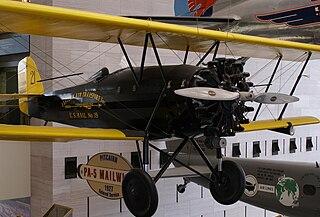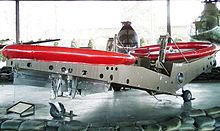
The AAI RQ-7 Shadow is an American unmanned aerial vehicle (UAV) used by the United States Army, Australian Army, Swedish Army, Turkish Air Force and Italian Army for reconnaissance, surveillance, target acquisition and battle damage assessment. Launched from a trailer-mounted pneumatic catapult, it is recovered with the aid of arresting gear similar to jets on an aircraft carrier. Its gimbal-mounted, digitally stabilized, liquid nitrogen-cooled electro-optical/infrared (EO/IR) camera relays video in real time via a C-band line-of-sight data link to the ground control station (GCS).

AAI Corporation is an aerospace and defense development and manufacturing firm, located in Hunt Valley, Maryland, US. Formerly a wholly owned subsidiary of United Industrial Corporation, AAI was acquired by Textron in 2007. It currently operates as a unit of Textron Systems and employs more than 2,000.
Piasecki Helicopter Corporation designed and manufactured helicopters in Philadelphia and nearby Morton, Pennsylvania, in the late 1940s and the 1950s. Its founder, Frank Piasecki, was ousted in 1956 and started a new company, Piasecki Aircraft. Piasecki Helicopter was renamed Vertol Corporation in early 1956. Vertol was acquired by Boeing in 1960 and renamed Boeing Vertol.

The Piasecki X-49 "SpeedHawk" is an American four-bladed, twin-engined experimental high-speed compound helicopter developed by Piasecki Aircraft. The X-49A is based on the airframe of a Sikorsky YSH-60F Seahawk, but utilizes Piasecki's proprietary vectored thrust ducted propeller (VTDP) design and includes the addition of lifting wings. The concept of the experimental program was to apply the VTDP technology to a production military helicopter to determine any benefit gained through increases in performance or useful load.

Frank Nicolas Piasecki was an American engineer and helicopter aviation pioneer. Piasecki pioneered tandem rotor helicopter designs and created the compound helicopter concept of vectored thrust using a ducted propeller.

The Boeing A160 Hummingbird is an unmanned aerial vehicle (UAV) helicopter. Its design incorporates many new technologies never before used in helicopters, allowing for greater endurance and altitude than any helicopter currently in operation.

A rotorcraft or rotary-wing aircraft is a heavier-than-air aircraft with rotary wings or rotor blades, which generate lift by rotating around a vertical mast. Several rotor blades mounted on a single mast are referred to as a rotor. The International Civil Aviation Organization (ICAO) defines a rotorcraft as "supported in flight by the reactions of the air on one or more rotors".

The Sikorsky X2 is an experimental high-speed compound helicopter with coaxial rotors, developed by Sikorsky Aircraft, that made its first flight in 2008 and was officially retired in 2011.
The U.S. Department of Defense (DoD) classifies unmanned aerial systems (UAS) into "Groups" according to their size and capability, a joint system that replaced the service branches' separate categorization schemes in 2011.

The American Helicopter Museum & Education Center (AHMEC) is located at 1220 American Boulevard, West Chester, Pennsylvania, United States. The transport museum focuses on the history, science and technology of rotary wing aviation. The collection contains over 40 civilian and military, autogyros, convertiplanes and helicopters, including some early generation models. The museum also has an extensive research library, the Renzo Pierpaoli Memorial Library, which contains documents, artifacts, films, and memoirs that museum members can use.

The Boeing AH-6 is a series of light helicopter gunships based on the MH-6 Little Bird and MD 500 family. Developed by Boeing Rotorcraft Systems, these include the Unmanned Little Bird (ULB) demonstrator, the A/MH-6X Mission Enhanced Little Bird (MELB), and the proposed AH-6I and AH-6S.

The Carter PAV is a two-bladed, compound autogyro developed by Carter Aviation Technologies to demonstrate slowed rotor technology. The design has an unpowered rotor mounted on top of the fuselage, wings like a conventional fixed-wing aircraft mounted underneath, and a controllable pitch pusher propeller at the rear of the fuselage. Heavy weights are placed in the rotor tips to enhance rotational energy and to reduce flapping.
Carter Aviation Technologies is a privately held aviation research and development company based in Wichita Falls, Texas, United States.
FCS/BCT unmanned aerial vehicles was a collection of unmanned aerial vehicles developed under the jurisdiction of the Future Combat Systems (FCS) program until it was dissolved and succeeded by the BCT Modernization program.

The Aerial Reconfigurable Embedded System (ARES) was a concept for an unmanned VTOL flight module that can transport various payloads. The concept started as the TX (Transformer) in 2009 for a terrain-independent transportation system centered on a ground vehicle that could be configured into a VTOL air vehicle and carry four troops. ARES' primary function was the same as TX, to use flight to avoid ground-based transportation threats like ambushes and IEDs for units that don't have helicopters for those missions. It was to be powered by twin tilting ducted fans and have its own power system, fuel, digital flight controls, and remote command-and-control interfaces. The flight module would have different detachable mission modules for specific purposes including cargo delivery, CASEVAC, and ISR. Up to 3,000 lb (1,400 kg) of payload would be carried by a module.

Future Vertical Lift (FVL) is a plan to develop a family of military helicopters for the United States Armed Forces. Five different sizes of aircraft are to be developed, sharing common hardware such as sensors, avionics, engines, and countermeasures. The U.S. Army has been considering the program since 2004. FVL is meant to develop replacements for the Army's UH-60 Black Hawk, AH-64 Apache, CH-47 Chinook, and OH-58 Kiowa helicopters. The precursor for FVL is the Joint Multi-Role (JMR) helicopter program.

The Pitcairn Aircraft Company was an American aircraft manufacturer of light utility aircraft. An early proponent of the autogyro, the company, later known as the Autogiro Company of America among other names, remained in business until 1948.
Unmanned aircraft system simulation focuses on training pilots to control an unmanned aircraft or its payload from a control station. Flight simulation involves a device that artificially re-creates aircraft flight and the environment in which it flies for pilot training, design, or other purposes. It includes replicating the equations that govern how aircraft fly, how they react to applications of flight controls, the effects of other aircraft systems, and how the aircraft reacts to external factors such as air density, turbulence, wind shear, cloud, precipitation, etc.

UMS Skeldar AG is an aircraft manufacturer based primarily in Switzerland, and with manufacturing facilities in Sweden. It was formed in 2018 as a joint venture between majority shareholder UMS Aero Group and Saab. Its principle product is the Skeldar range of unmanned aircraft systems (UAS) rotorcraft. The company also owns the Hirth company, whose range of light two-stroke engines provide the power units for the rotorcraft.















